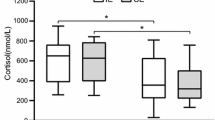Abstract
The purpose of the present study was to test the hypothesis that the magnitude of hormonal concentration alterations during a prolonged military field exercise with constant energy intake (EI) is influenced by changes in energy deficit (ED) induced by varying the exercise intensity. Basal serum hormone concentrations were measured in a group of healthy young male volunteers (n = 7) during a 20-day field exercise. During the first week of the exercise, the average ED was 4,000 kcal/day (P-I), in the second week only 450 kcal/day (P-II), and in the last week 1,000 kcal/day (P-III). During the first 5 days of the field exercise, significant increases in cortisol (COR, +32%) and growth hormone (GH, +616%) concentrations were observed, while insulin (INS, −70%), total testosterone (TES, −27%), free testosterone (TESfree, −26%) decreased. However, after these initial responses, COR and GH returned to the pre-exercise level by the beginning of P-II. Also TES and TESfree recovered to the pre-exercise level by the beginning of P-III, and INS by the end of P-III. The concentration of TES (+29%) increased above the pre-exercise level by the beginning of P-III. Serum thyroxin (T4) concentration was significantly lesser (−12%) and urine urea concentration significantly higher (+78%) after the field exercise than before it. Therefore, it can be concluded that the lower levels of ED in the second and third phase (ED <1,000 kcal/day) allowed recovery of hormonal changes observed in the first phase with ED much greater than 1000 kcal/day.






Similar content being viewed by others
References
Clarkson PM, Nosaka K, Braun B (1992) Muscle function after exercise-induced muscle damage and rapid adaptation. Med Sci Sports Exerc 24:512–520
Crouter SE, Albright C, Bassett JR (2004) Accuracy of Polar S410 Heart Rate Monitor to Estimate Energy Cost of Exercise. Med Sci Sports Exerc 36:1433–1439
Dill DB, Costill DL (1974) Calculation of percentage changes in volumes of blood, plasma, and red cells in dehydration. J Appl Physiol 37:247–248
Fallon KE, Sivyer G, Sivyer K, Dare A (1999) The biochemistry of runners in a 1,600 km ultramarathon. Br J Sports Med 33:264–269
Friedl KE, Hoyt RW (1997) Development and biomedical testing of military operational rations. Ann Rev Nutr 17:51–75
Friedl KE, Moore RJ, Hoyt RW, Marchitelli LJ, Martinez-Lopez LE, Askew EW (2000) Endocrine markers of semistarvation in healthy men in a multistressor environment. J Appl Physiol 88:1820–1830
Gomes-Merino D, Chennaoui M, Burnatt P, Drogou C, Guezennec CY (2003) Immune and hormonal changes following intense military training. Mil Med 186:1034
Hoyt RW, Opstad PK, Haugen A-H, DeLany JP, Cymerman A, Friedl KE (2006) Negative energy balance in male and female rangers: effects of 7 d of sustained exercise and food deprivation. Am J Clin Nutr 83:1068–1075
Jackson AS, Pollock ML (1985) Practical assessment of body composition. Phys Sportsmed 13:76–90
Griffin JE (2004) The Thyroid. In: Griffin JE, Ojeda SR (eds) Textbook of endocrine physiology. Oxford University Press, New York p 302
McHugh MP (2003) Recent advances in the understanding of the repeated bout effect: the protective effect against muscle damage from a single bout of eccentric exercise. Scand J Med Sci Sports 13:88–97
McHugh MP, Connolly DAJ, Eston RG, Gleim GW (1999) Exercise-induced muscle damage and potential mechanisms for the repeated bout effect. Sports Med 27:157–170
Morgan III CA, Wang S, Mason J et al. (2000) Hormone profiles in humans experiencing military survival training. Biol Psychiatry 47:891–901
Nindl BC, Friedl KE, Frykman PN, Marchitelli LJ, Shippee RL, Patton JF (1997) Physical performance and metabolic recovery among lean, healthy men following a prolonged energy deficit. Int J Sports Med 18:317–24
Nindl BC, Leone CD, Tharion WJ, Johnson RF, Castellani JW, Patton JF, Montain SJ (2002) Physical performance responses during 72 h of military operational stress. Med Sci Sports Exerc 34:1914–1822
Nindl BC, Castellani JW, Young AJ, et al. (2003) Differential responses of IGF-1 molecular complexes to military operational field training. J Appl Physiol 95:1083–1089
Nindl BC, Rarick KR, Castellani JW, Tuckow AP, Patton JF, Young AJ, Montain SJ (2006) Altered secretion of growth hormone and luteinizing hormone after 84 h of sustained physical exerction superimposed on caloric and sleep restriction. J Appl Phys 100:120–128
Noakes TD (1987) Effect of exercise on serum enzyme activities in humans. Sports Med 4:245–267
Opstad P (1991) Alterations in the morning plasma levels of hormones and the endocrine responses to bicycle exercise during prolonged strain: the significance of energy and sleep deprivation. Acta Endocrinol 125:14–22
Opstad P (1992) Androgenic hormones during prolonged physical stress, sleep and energy deficiency. J Clin Endocrinol Metab 74:1176–1183
Opstad P (1994) Circadian rhythm of hormones is extinguished during prolonged physical stress, sleep and energy deficiency in young men. Eur J Endocrinol 131:56–66
Opstad P (1995) Medical consequences in young men of prolonged physical stress with sleep and energy deficiency. NDRE/PUBLICATION-95/05586, Forsvarets Forskningsinstitut
Roemmich JN, Sinning WE (1997) Weight loss, wrestling training: effects on growth-related hormones. J Appl Physiol 82:1760–1764
Ross JH, Attwood EC, Atkin GE et al. (1983) A study of the effects of severe repetitive exercise on myoglobin creatine kinase, transaminases and lactate dehydrogenase. QJM 206:268–79
Acknowledgments
The authors would like to express their gratitude to the Finnish Defense Forces for financially supporting the study. Furthermore, we wish to thank all the subjects who volunteered for the study
Author information
Authors and Affiliations
Corresponding author
Rights and permissions
About this article
Cite this article
Kyröläinen, H., Karinkanta, J., Santtila, M. et al. Hormonal responses during a prolonged military field exercise with variable exercise intensity. Eur J Appl Physiol 102, 539–546 (2008). https://doi.org/10.1007/s00421-007-0619-0
Accepted:
Published:
Issue Date:
DOI: https://doi.org/10.1007/s00421-007-0619-0




